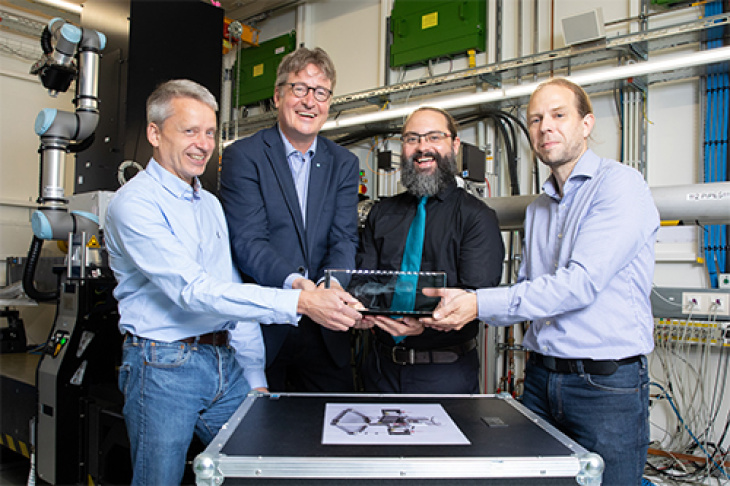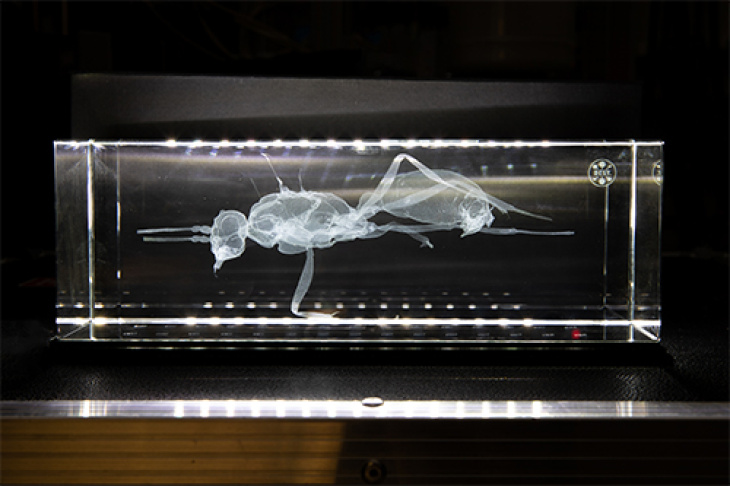New ant species named after Hereon
The researchers, from Friedrich Schiller University Jena, the University of Rennes in France, the University of Gdansk in Poland, as well as the Helmholtz-Zentrum Hereon in Geesthacht, Germany, discovered a previously unknown extinct ant species. The name given to the new species and genus is †Desyopone hereon gen. et sp. nov. In this way, the scientists are honouring the German Electron Synchrotron (DESY) in Hamburg and Hereon which contributed significantly to this find with the help of modern imaging techniques. Ultimately, it was only possible to identify the new species and genus through the combination of extensive phenotype data from scans and recent findings from genome analyses of living ants. The team reports on its discovery in the journal “Insects”.

A proud team: Prof Martin Müller (Hereon), Prof Christian Schroer (DESY), Dr Brendon Boudinot (Friedrich Schiller University Jena), Dr Jörg Hammel (Hereon) Photo: DESY/ Marta Mayer
What was initially thought to be representatives of an already known subspecies turned out to be a surprising new discovery: the research team involving the Helmholtz-Zentrum Hereon has discovered a new, fossil ant species. The technology of Hereon and the German Electron Synchrotron (DESY) has made a decisive contribution. Because of their high-resolution images obtained by synchrotron micro-computed tomography, the team had to revise their first thesis:
“The complex waist segment and the large but rudimentary mandibles – the mouthparts – are more familiar to us from the Ponerinae, a group of predatory ants,” says Dr Brendon Boudinot, who is currently working at the University of Jena on a Humboldt Research Fellowship. “For this reason, we’ve assigned the new species and genus to this subfamily, even though it has a unique appearance, as the long waist and otherwise unconstricted abdomen are more reminiscent of the Aneuretinae.” The decisive contribution of Hereon and DESY is honoured with the name. The new species is now called †Desyopone hereon gen. et sp. nov.
Unique amber

The detail shows the beauty Photo: DESY/ Marta Mayer
Not only the classification but also the dating of the find presented the scientists with some challenges, as the amber itself is as unique as the organisms inside it. “The piece is from the only amber deposit known from Africa that features fossil organisms in inclusions. Altogether, there are only a few fossil insects from this continent. Although amber has long been used as jewellery by locals in the region, its scientific significance has only become clear to researchers in the last 10 years or so,” explains Vincent Perrichot from the University of Rennes. “The specimen therefore offers what is currently a unique insight into an ancient forest ecosystem in Africa.” It dates from the early Miocene and is 16 to 23 million years old, says Perrichot. Its complicated dating was only possible indirectly, by determining the age of the fossil spores and pollen enclosed in the amber.
Modern methods for looking into the past
Research results such as these are only possible through the use of state-of-the-art technology. As the genetic material of fossils cannot be analysed, precise data and observations on the morphology of animals are particularly important. Comprehensive data can be obtained using high-resolution imaging techniques, such as micro-computed tomography (CT), in which X-rays are used to look through all layers of the sample.
“Since the ants enclosed in amber that are to be examined are very small and only show a very weak contrast in classical CT, we carried out the CT at our measuring station that is specialised in micro tomography,” explains Dr Jörg Hammel from Helmholtz-Zentrum Hereon. “This provided the researchers with a stack of images that basically showed the sample that was being studied slice by slice.”
Put together, these produced detailed three-dimensional images of the internal structure of the animals, which the researchers could use to reconstruct the anatomy with precision. This was the only way to exactly identify the details that ultimately led to the new species and genus being determined.
Further Information
- Original publication Brendon E. Boudinot, Adrian K. Richter, Jörg U. Hammel, Jacek Szwedo, Błażej Bojarski, Vincent Perrichot: „Genomic-phenomic reciprocal illumination: †Desyopone hereon gen. et sp. nov., an exceptional aneuretine-like fossil ant from Ethiopian amber (Hymenoptera: Formicidae: Ponerinae)“, Insects, 2022
- Press Release Friedrich Schiller Universität Jena
- Website Institute of Materials Physics
Contact
Scientist
Phone: +49 (0) 40 8998-5303
Institute of Materials Physics
Helmholtz-Zentrum Hereon
Press Officer
Phone: +49 (0) 4152 87-1648
Communication and Media
Helmholtz-Zentrum Hereon
